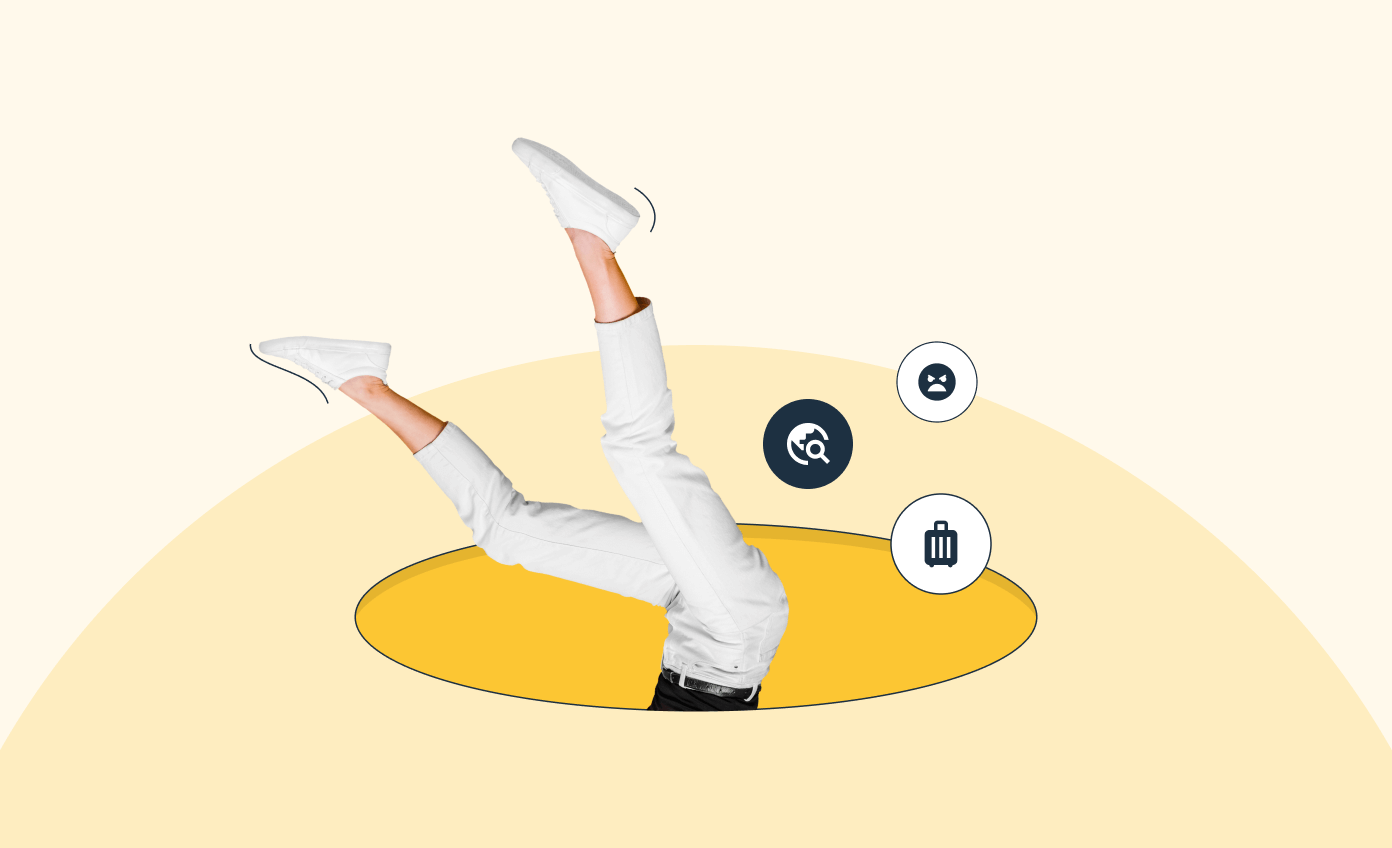Let’s face it:
Tourist traps are often chided for their commercialized nature, steep prices, and lack of authenticity.
Yet—
They are still a HUGE draw for travelers.
The reason?
At PhotoAiD, we’ve surveyed over 1,000 Americans to find out. Read on for the insights we gathered, and grab some pro tips on how to avoid tourist traps.
Key Takeaways
- The top factors contributing to a place being labeled as a tourist trap are above-average pricing (30%), amenities tailored for tourists (28%), and lack of cultural authenticity (27%).
- About 89% of Americans have visited a tourist trap more than once in the past two years.
- Roughly 82% of respondents were set back over $50 at the last tourist trap they visited, with 22% spending $201 or more.
- Nearly 70% of travelers felt their recent visit to a tourist trap diminished their trip enjoyment.
- The Skylon Tower in Niagara Falls, Canada, was named the #1 global tourist trap, while California’s Fisherman’s Wharf led the pack in the US.
- The top advice on how to avoid a tourist trap is to visit well-known landmarks without making them the main focus of your trip (16%).
High Prices, Tailored Amenities, and Lack of Authenticity Signal Tourist Traps
Whether or not an attraction is a tourist trap is largely subjective.
Take the Eiffel Tower.
While some locals may roll their eyes and dub it a tourist trap, can you go to Paris and skip this iconic structure?
Sure, you might be surrounded by throngs of tourists (all snapping away with their cameras) and feel regret as you fork over money for an overpriced souvenir at a gift shop nearby.
Yet—
The magic of this monument, overlooking the City of Lights, is undeniable.
But then, there are places like Romeo and Juliet’s balcony in Verona, Italy.
Most visitors believe this is where the star-crossed lovers whispered sweet nothings to each other. In reality, you’ll find yourself elbowing through some 10,000 people just to glimpse a balcony erected after Shakespeare wrote the play.
So, to help settle the debate, we asked survey respondents to identify what factors scream “tourist trap” to them.
Below are the results:
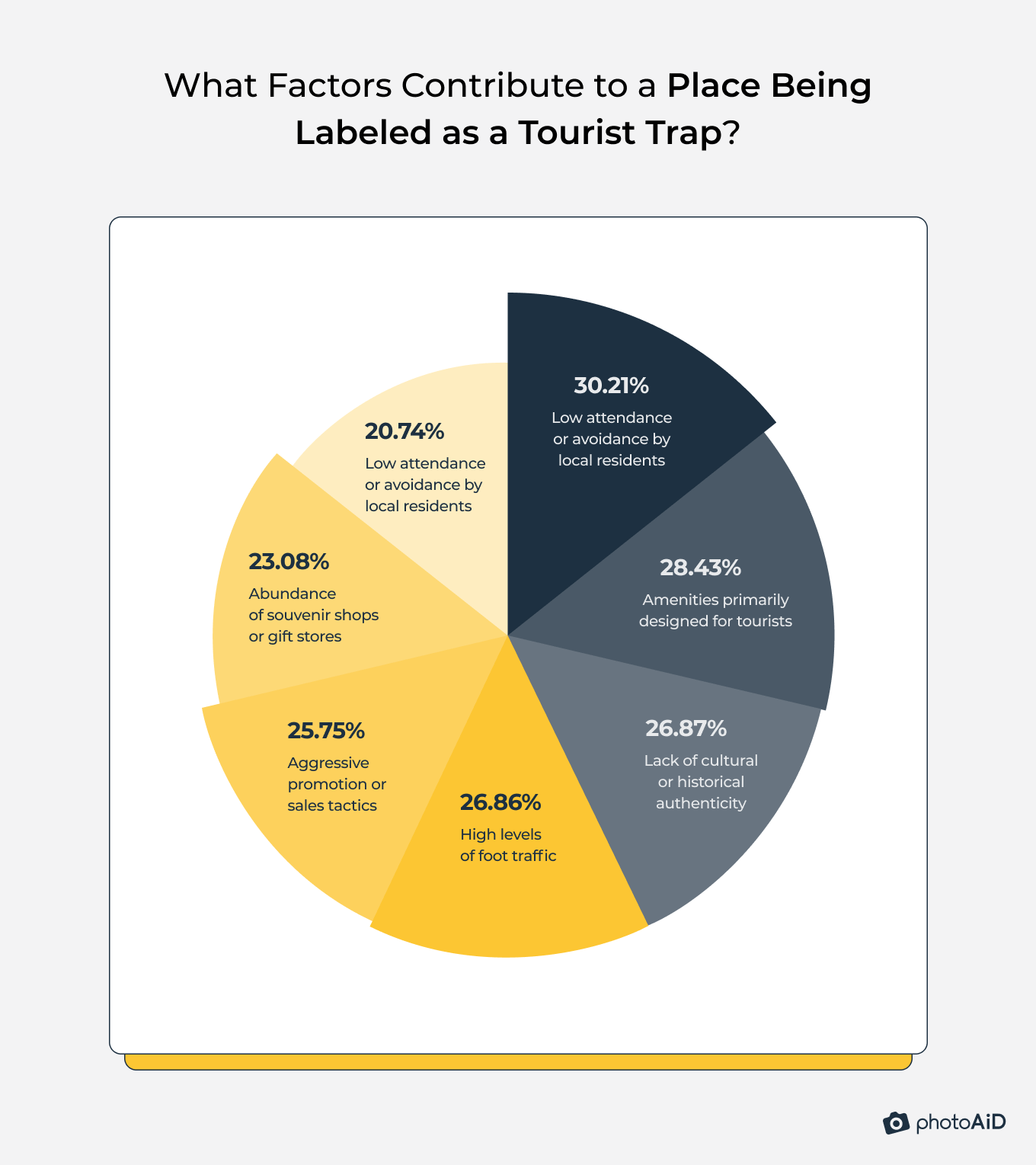
The data reveals that high prices (30%), amenities specifically tailored for tourists (28%), and, perhaps most importantly, lack of cultural or historical authenticity (27%) are the telltale signs of a tourist trap.
Wouldn’t you agree?
Nearly 9 in 10 Americans Have Been to a Tourist Trap Recently
Having established what typically makes an attraction a tourist trap, we wanted to delve deeper and ask respondents about their recent encounters with such places.
Here’s what we found:
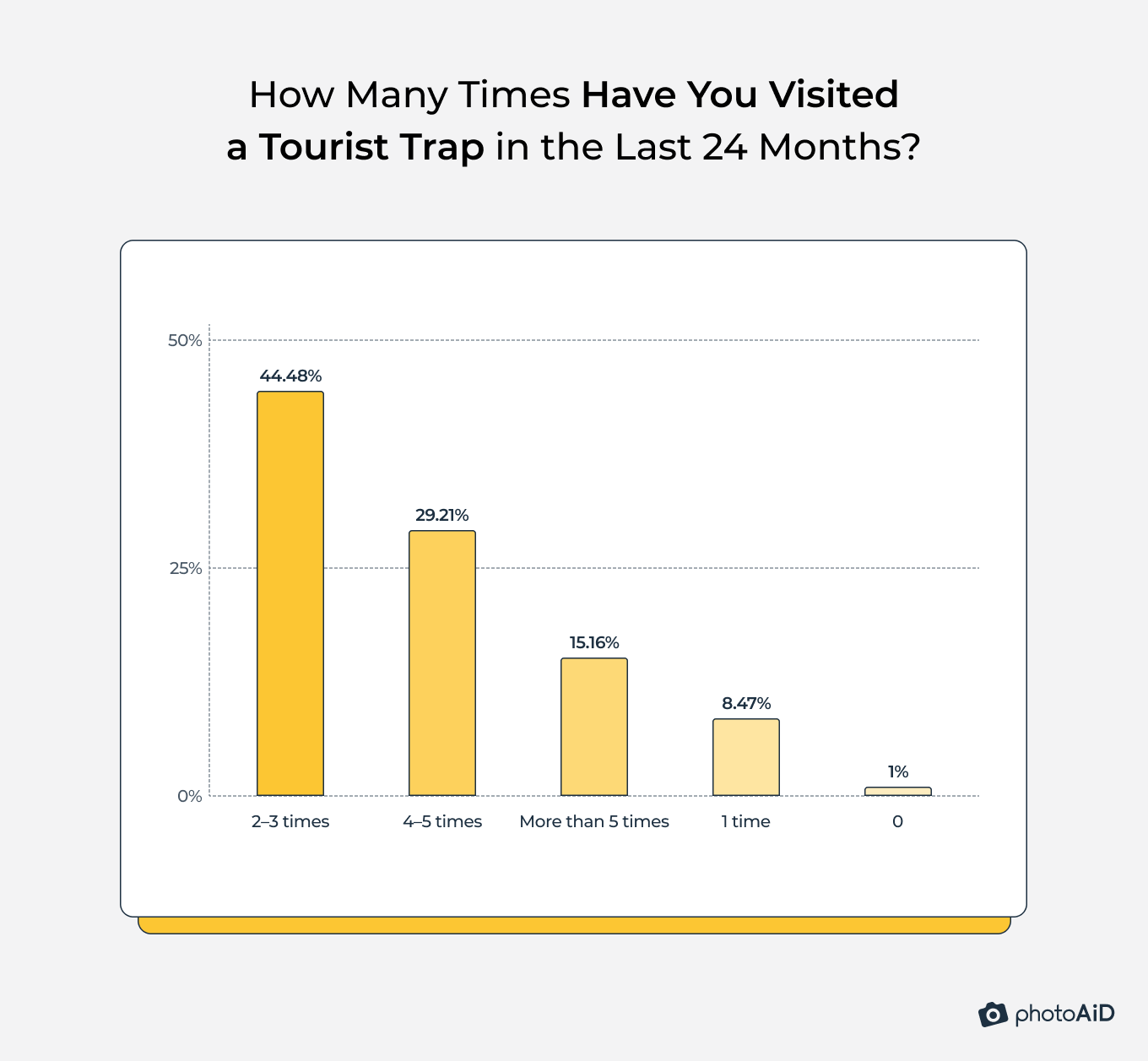
A significant 89% of respondents admit to having visited what they’d call a tourist trap more than once in the past two years.
This further shows these spots have a magnetic pull despite the flak they often receive.
But—what drives us to them?
Let’s take a look:
| What Was the Primary Reason for Your Most Recent Visit to a Tourist Trap? | In % |
|---|---|
| Family/friends wanted to go | 33.67 |
| Highly recommended in guides/reviews/on social media | 19.29 |
| Curiosity or personal interest | 18.17 |
| Considered a landmark or symbol of the destination | 14.16 |
| Part of a tour package or itinerary | 13.82 |
The data suggests social and external influences are major factors.
Over half of Americans (~53%) indicated they were swayed by recommendations from family and friends or online media. So, think twice the next time someone insists on that “must-visit” spot.
Lastly, we wanted to examine how much visiting a tourist trap can mar the travel experience.
The results are in:
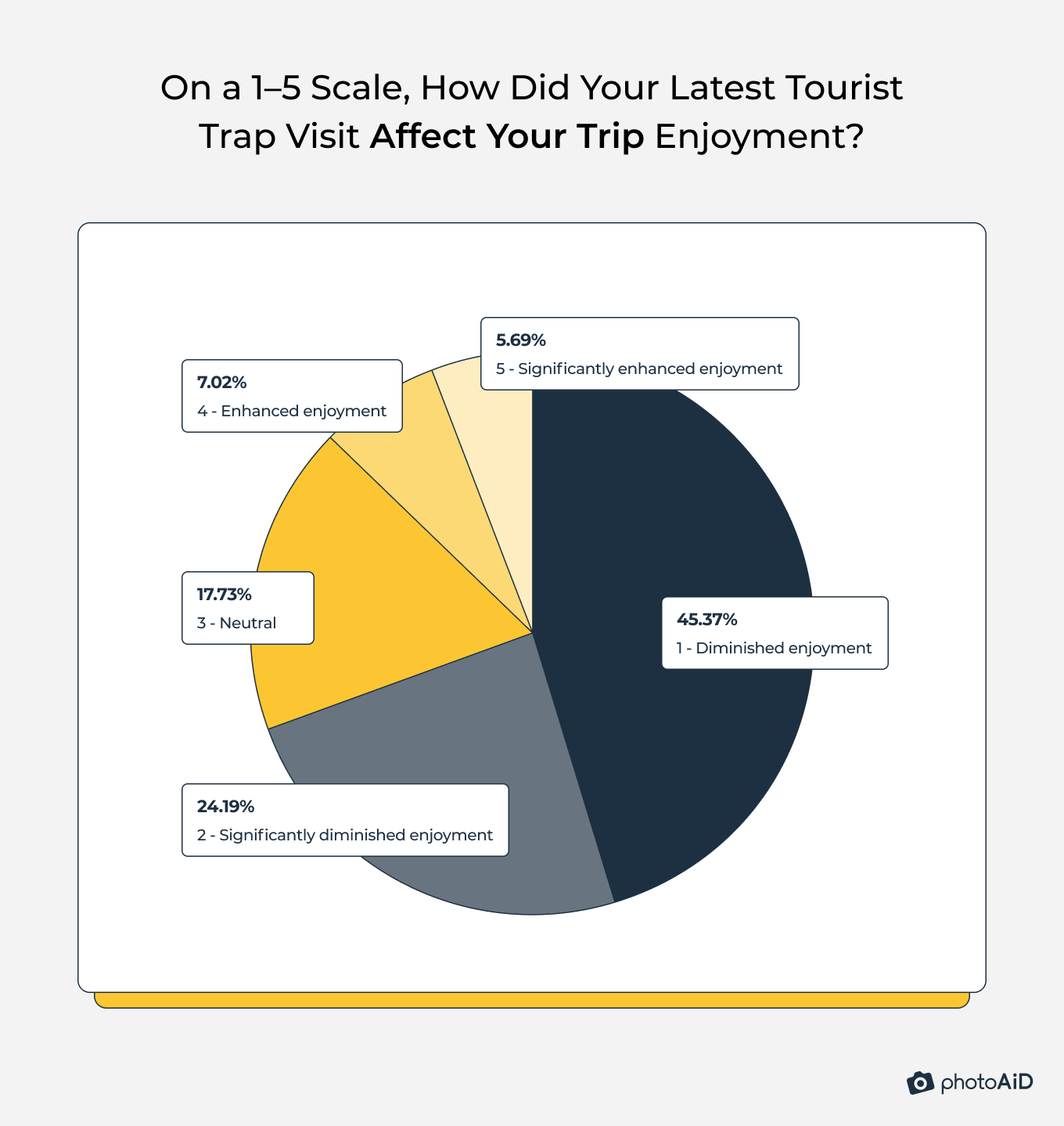
Regrettably, almost 70% of respondents said their overall trip enjoyment took a hit.
One potential reason for the lackluster experience? The dent in their wallets.
| How Much Money Do You Estimate You Spent at the Most Recent Tourist Trap You Visited? (in USD) | In % |
|---|---|
| $101–200 | 39.69 |
| $201 or more | 21.96 |
| $51–100 | 20.62 |
| $1–50 | 14.27 |
| $0 | 0 |
About 82% of participants revealed they had spent more than $50 at these places, with around 22% admitting to shelling out $201 or more.
This testifies to the high commercial nature of such spots.
But fret not.
In our next sections, we’ll unveil the most “trappy” attractions in the eyes of the public to help you sidestep them on your next adventure.
Skylon Tower Ranked the World’s #1 Tourist Trap
So far, so good.
Now—
Using the USA Today data, we compiled a list of the world’s most visited tourist attractions that many view as tourist traps. We then passed this list to our survey participants, asking them to pick which spots felt most “trappy.”
Below are the top seven that made the cut:

As you can see, Skylon Tower in Niagara Falls, Canada, claimed the top spot with about 10% of the vote.
Hot on its heels were the Moulin Rouge in Paris, France (9%), and the Blue Lagoon in Grindavik, Iceland (8%).
Why is Skylon Tower deemed the biggest tourist trap?
It’s an iconic fixture, offering panoramic views of the magnificent Niagara Falls.
But—
Many visitors voice concerns over the long wait times and exorbitant admission fees. Plus, other viewpoints in the area offer comparable views without the hefty price tag and crowds.
Now, if you’re curious about the most hyped-up tourist spots in the US, our next section spills the beans.
Fisherman’s Wharf Was Voted The Biggest Tourist Trap in the US
Without beating much around the bush, let’s jump straight to the heart of the matter:
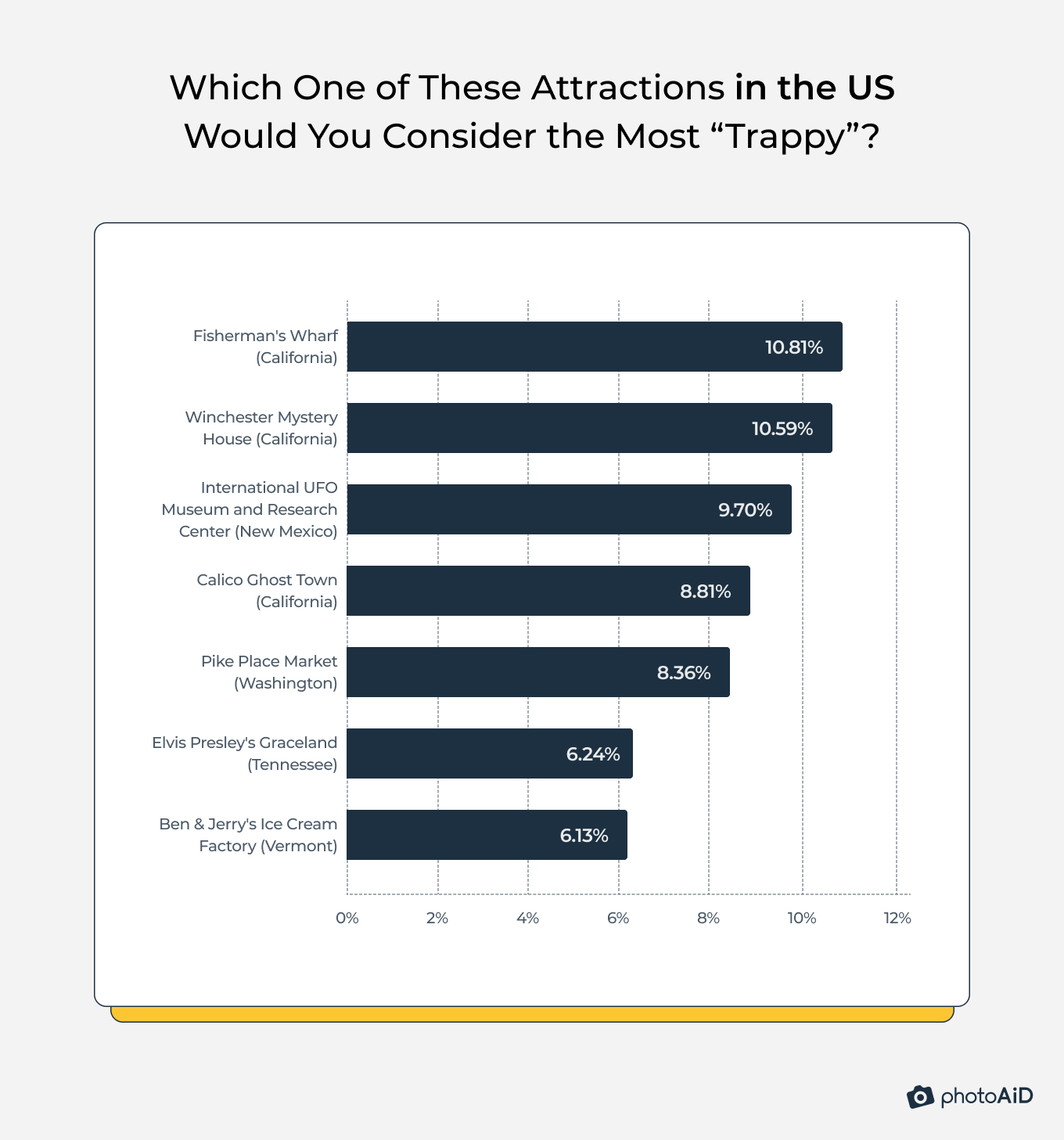
As you can see, Fisherman’s Wharf is the frontrunner, pulling in ~11% of the vote.
So, what gives?
At face value, it promises a quintessential San Francisco experience. It has seaside charm, historic flavor, and postcard views of Alcatraz and the Golden Gate Bridge.
Yet—
Visitors lament the hordes of crowds, overpriced eateries, and the barrage of typical souvenir shops that overshadow the genuine, local charm it once held.
Does that mean you should steer clear of the wharf?
Not exactly.
After all, every San Francisco first-timer is drawn to this landmark. Instead, be mindful that while the views are a catch, it’s easy to get hooked on the touristy trappings.
8 Actionable Tips on How to Avoid Tourist Traps
In our last section, we aimed to give fellow travelers insights to bypass tourist traps.
So—
We presented respondents with tactical tips and asked them to identify the one they found most helpful.
Let’s dive into the results:
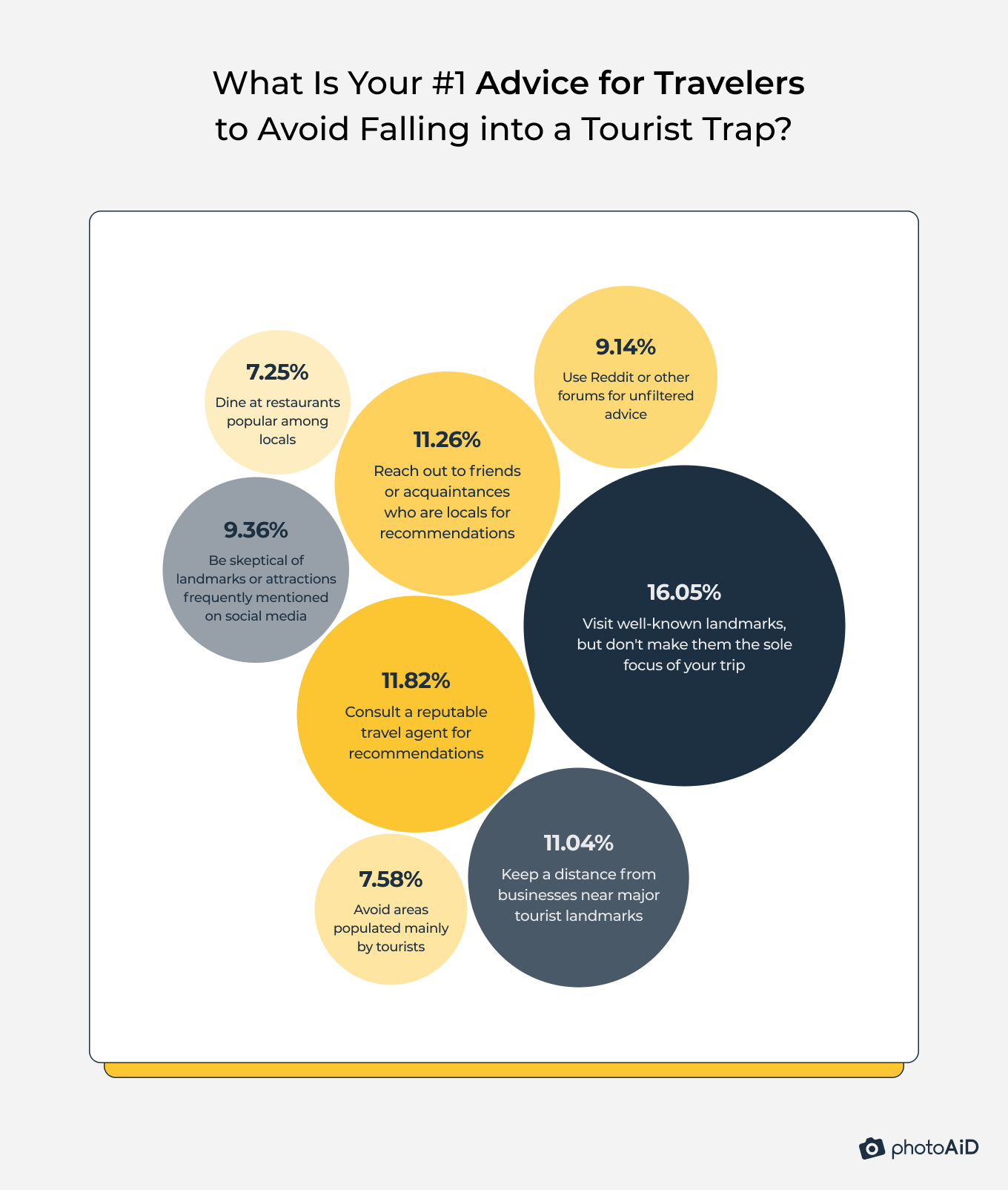
The leading piece of advice, with roughly 16%, is not to shun popular sites but to avoid making them the sole focus of your trip.
Plus, it’s a good idea to lean into personal connections and seek professional advice.
Travel agents (12%) and local acquaintances (11%) are often the gateway to hidden gems, eateries favored by locals, and experiences that might not be on every traveler’s radar.
With this, safe travels!
Methodology
We conducted an online survey of 1,002 US respondents who had traveled for leisure in the past 24 months and had been primarily or jointly responsible for travel planning via a bespoke online polling tool in September 2023.
The respondents were 58.1% male, 41.7% female, and 0.2% identified as other. 28.9% of respondents were 26 or younger, 51.4% were aged 27–42, 15.6% were aged 43–58, and 4.1% were 59 or older.
This survey has a confidence level of 95% and a margin of error of 3%. Given the gender and age makeup of our sample size, the study’s findings are statistically significant for the population at large.
This study was created through multiple research steps, crowdsourcing, and surveying. Data scientists reviewed all survey participants’ responses for quality control. The survey also had an attention-check question.
Sources
- BuzzFeed, “Over-Hyped Attractions Around The World”
- Insider, “8 Warning Signs You’re About to Visit a Tourist Trap”
- Lifehacker, “How to Spot the Worst Tourist Traps (and When to Just Give In and Visit Them)”
- Thrillist, “Most Overrated Tourist Traps in the World Ranked in New USA Today Study”

As a Digital PR specialist and a member of the Society of Professional Journalists (SPJ), I have 5+ years of writing experience.
Over the course of my career, my work has garnered significant attention, with features in numerous prominent publications such as The New York Times, Forbes, Inc., Business Insider, Fast Company, Entrepreneur, BBC, TechRepublic, Glassdoor, and G2.
